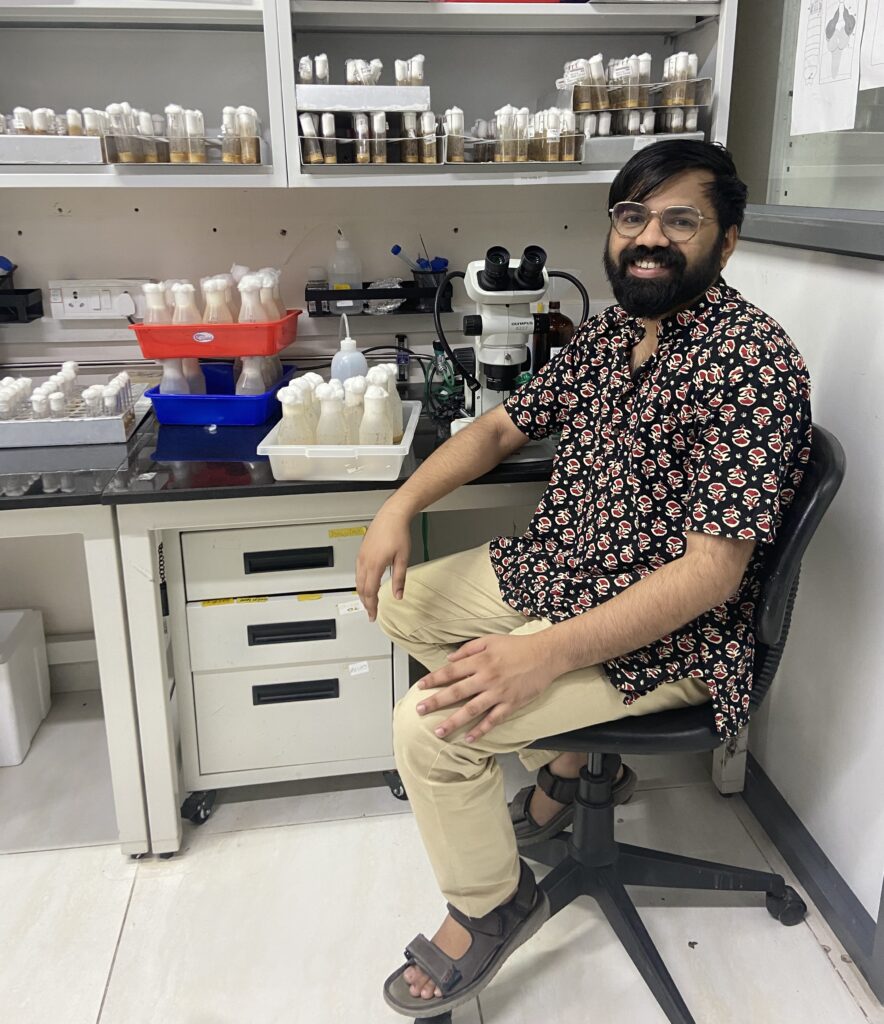Aravind H is a graduate student in the lab of Dr. Manish Jaiswal at TIFR-Hyderabad. His poster was among the few that were awarded the best poster award at InSDB24. Here, Aravind talks about his work, and his experience at the conference.
Tell us a little bit about the work you presented in your poster
I primarily work on mitochondrial dynamics during development using Drosophila spermatogenesis as the model system.
The reason why I use this system is because spermatogenesis in drosophila is associated with distinct changes in mitochondrial morphology, so much so that one can roughly identify what stage of spermatogenesis the cells are in by just looking at the mitochondrial morphology.
During spermatogenesis, the cells modulate the shape of the mitochondria to produce mitochondria that are several millimeters long. This is in comparison to the micrometer-long mitochondria that we see in other systems. This change in the dynamics requires tremendous coordination between several components involved in the fusion, division, and other dynamics of mitochondria. I was interested in understanding how these regulations happen.
How did you go about doing this?
During spermatogenesis, all the mitochondria aggregate and fuse to form a ball-like structure called nebenkern. They then divide and elongate, taking lengths of millimeters. We use a combination of genetics and high-resolution imaging to understand what happens in the nebenkern that transforms small mitochondrion into these really long filaments.
So, what did you find happens to the mitochondria in the nebenkern?
Earlier, it was thought that the nebenkern is two large intertwined mitochondria that later unfurl and start elongating.
However, our studies show that they are not two different mitochondria, but rather, a single structure. Somehow, a plane is being decided, and they get divided exactly in the middle, by bringing in factors required for mitochondrial division. The elongation occurs along the axoneme of the sperm. Interestingly, during elongation, the mitochondrial derivatives act as MTOC (Microtubule-Organizing Centre) which induces microtubule polymerization and elongation on the mitochondrial surface. This elongation lengthens the sperm as well as enables the mitochondria to stretch by coupling itself to the elongating microtubules.
Once division starts, there is a developmentally regulated event where several outer mitochondrial proteins get degraded. One such protein is the fusion protein called mitofusin/Marf. We found out that once the mitochondria divide, Marf degradation prevents their re-fusion. We validated this using mutants of flies where Marf degradation was affected, and in those mutant flies, the divided mitochondria start re-fusing together and then they remain as a single mitochondrion which could eventually lead to sterility.
How did you get into this research? What made you choose this topic for you?
It was serendipitous. I was working on another project that required me to look at mitochondria in testes. While doing this, I observed that the protein levels of two similar-looking stages of two similar-looking mitochondria were different: one had higher levels than the other. This was when I started asking why there was a disparity and that’s how I started with this work.

It’s really interesting to hear how you bumped into this! Do you want to tell us about any talks or posters at InSDB24 that intrigued you the most?
Several of them! I do not have a strong theoretical background, and the session on quantitative approaches to devbio was something that I thought I was not going to enjoy. But it ended up being the most interesting session for me!
What was the most exciting part of the conference for you?
I have not presented this work elsewhere. Hence, presenting this was exciting for me. Listening to people like Lynn Riddiford (whose work I have read a lot) talk was exciting. Overall, it was a holistic experience.
What are your future plans?
At the moment, I am wrapping up this work and publishing it soon. The other works are also in their final stages, and I hope to graduate soon!
All the best, Aravind, and congratulations on the poster prize!





